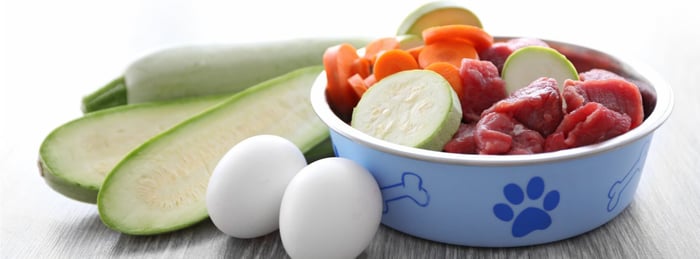Homemade Dog Food: What You Need to Know
With so many dog food varieties on the market, it’s natural for dog owners to feel a bit overwhelmed.
You probably know that purchasing the cheapest dog food off the shelf is not the best way to support your athletic dog’s health… But do you need to buy the most expensive type? Should you add table foods to your dog’s diet?
What about simply avoiding all of the fillers and by-products added to commercial dog foods and making your own food instead?
Many dog owners, particularly those who have athletic dogs, are turning to natural solutions in response to the question of, “What should I feed my dog?” Simply feeding your dog table scraps isn’t the answer, however.
Neither is throwing together a motley medley of foods in the hopes that your dog will get the requisite amounts of carbohydrates, fat, proteins, and nutrients. Making homemade dog food is not quite as simple as some think it is, but it’s also not very difficult once you understand the basics and settle on a recipe that works for your dog.
Read on to find out what you need to do when making homemade dog food to ensure that your furry friend’s nutritional needs are being met.
Consider Meeting with a Pet Nutritionist

If your dog is active on the sporting field, on the agility course, or in the show ring, he has needs that are above and beyond what typical “couch potato” dogs need.
A pet nutritionist will be able to tell you what your dog needs in terms of macros (fats, carbs, and proteins) as well as vitamins and minerals.
He or she will be able to recommend a specific recipe for homemade dog food that will meet all of those needs.
It’s not a bad idea to have your vet give your pet a once-over, too, so any underlying health issues can be discovered and addressed through the new diet.
Make the Change Slowly
Switching from commercial dog food to one based on foods that humans eat is going to be a bit of a shock to your dog’s system, so proceed slowly and with caution.
Start by adding a small amount of the homemade dog food to your pet’s usual meal. As each week passes, gradually reduce the amount of commercial food you’re putting in his bowl and increase the amount of the new food.
It might take a month to completely make the transition. Your patience will be rewarded with a lack of stomach upset and diarrhea on the part of your dog.
Follow the Recipe Faithfully
While you might like to experiment with your own meals by adding a bit of this and taking away a bit of that, it’s not a good idea to change around what works when it comes to your dog’s diet.
First, whether you have a custom-designed recipe or are using one that many others use, it’s going to be based on a specific number of calories, fats, amino acids, carbohydrates, and proteins.
Changing things around (for example, taking off chicken skin that was meant to be left on or substituting sweet potatoes for white potatoes) will change the nutritional balance that you’ve worked hard to achieve.
With that being said, if your dog seems to be having ill effects from the diet, talk to your vet or nutritionist about whether it’s better to wait and see or to change the food.
Excessive gas, diarrhea, vomiting, constipation, fur loss, itching, or other side effects could be his digestive system adjusting or could be an early sign of an allergy or intolerance.
An evaluation is in order if you notice these types of symptoms. Also, if your dog is losing or gaining weight and the diet was not meant to produce those changes, check in with your veterinarian.
Consider Adding Supplements
Your dog might not be able to get everything he needs from his diet, so adding supplements might be warranted. But don’t give your dog anything, particularly if it’s not specifically made for dogs or if he also takes any type of medication, without checking with your vet first.
1TDC™ is a supplement that’s very popular among sporting dog owners. It supports their joint health, oral health, and performance both on and off the field.
It also gives your dog a shiny coat and supple skin that’s neither too oily nor too dry. If you participate in agility, flyball, or other dog sports, 1TDC™ may make a noticeable difference in your dog’s health, stamina, and recovery.
Before changing your dog’s diet, check in with a veterinarian or animal nutritionist. Once you get the all clear, proceed slowly and watch your dog to glean insight into how he is tolerating the new diet.
In time, you might be able to have your dog on a completely homemade diet so you can stop relying on commercial dog food products.
The following video shows you how to create a balanced meal for your dog: https://www.facebook.com/PlanetPaws.ca/videos/vl.950018338478007/1160712844003596/?type=1









